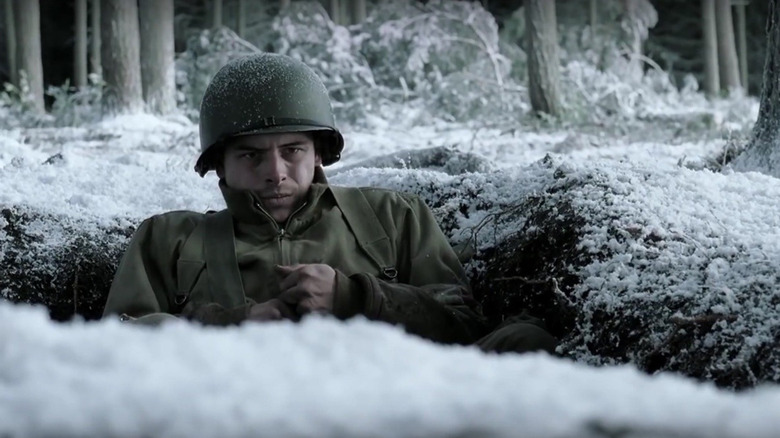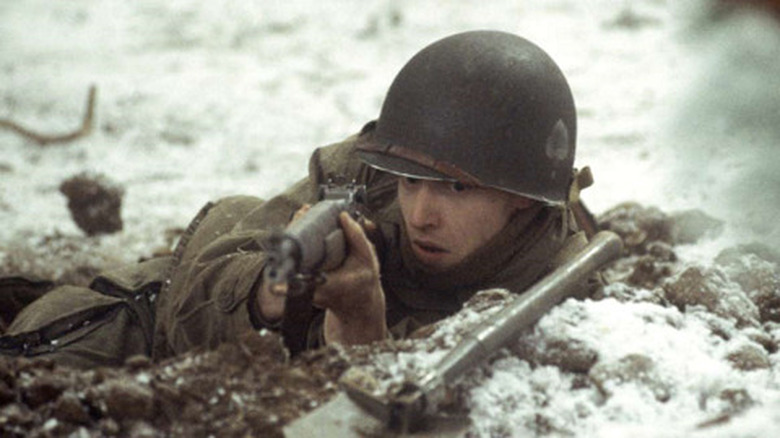Band Of Brothers' Bastogne Forest Wasn't Actually A Forest At All
It's known that HBO's 10-part miniseries "Band of Brothers" is something of an extension of Steven Spielberg's celebrated 1998 war film "Saving Private Ryan." Part of the reverence for the Spielberg-Tom Hanks co-creation comes from an appreciation for the meticulously re-created history, from Belgian villages to liberated concentration camps; the production even shares the filming location of Ellenbrooke Fields with "Saving Private Ryan." Paired with interview excerpts from some of the real-life survivors, it makes for as-authentic-as-you-can-get storytelling.
"Bastogne" is the 6th episode in the series, one that sees the men of the 101st Airborne Division's "Easy" Company make their way through the European theater of WWII and specifically Germany's final offensive, known as the Battle of the Bulge. Focusing on the efforts of Medic Eugene Roe (played by Shane Taylor) as he renders aid to the wounded — for context, Americans incurred 47,500 wounded during the real Ardennes Offensive – Roe's journey through snow-covered death and destruction makes the episode one of the most harrowing of the series entire.
Watch the moment the men of Easy Company make contact with overwhelming German firepower (content warning for blood):
It's one of the most brutal moments of the show, as it observes the slow-suffering death of a young soldier and the anguish of the men who are unable to save him in time. The icy surroundings make the circumstances all the more dire for the men as they struggle to stay warm and sheltered; it may be a surprise to learn that the frigid forest of Bastogne was not a real forest at all — and neither was the snow.
Let it snow
The show's art department constructed the Bastogne set using two hundred and fifty special-made trees courtesy of the special effects unit. According to the "Band of Brothers" making-of featurette, a nifty technique was used for the moments when a mortar round would blow a tree in half onscreen.
Special effects supervisor Joss Williams reunited with Spielberg on the project, moving up from his previous special effects assistant gig on two of the filmmaker's "Indiana Jones" over a decade prior. In the featurette, Williams describes the process of blowing up trees, noting how the Germans would fight their battles, and adjusting the look accordingly:
"We created our own trees, which are a mixture of fiberglass, hemp, and latex, to give a shattered tree look, and foam trees with a cardboard tubs core, that keeps the weight down. The Germans, for that section of the war, had timers on their mortar rounds so they would explode in the treetops. So the soldiers not only got the shrapnel from the mortar rounds, but they've got shrapnel from the trees getting hit."
The result allows viewers to hear the mortar round, hear the impact, and watch a tree crack in half and topple in frame. To both actors and the audience, it looks and sounds as though the tree took a hard blow. A further four weeks of work was required to dress the set with faux snow, which snow effects supervisor (a dream job, really) David Crownshaw describes as a sort of cellulose-polymer-plastic-paper blend, about a third of a million pounds' worth — the largest amount sprinkled or blown onto a set, he claims. By taking care of the details, from the biggest tanks down to the smallest snowflake, "Band of Brothers" earns a salute for one of the most period-accurate miniseries to hit the small screen.

